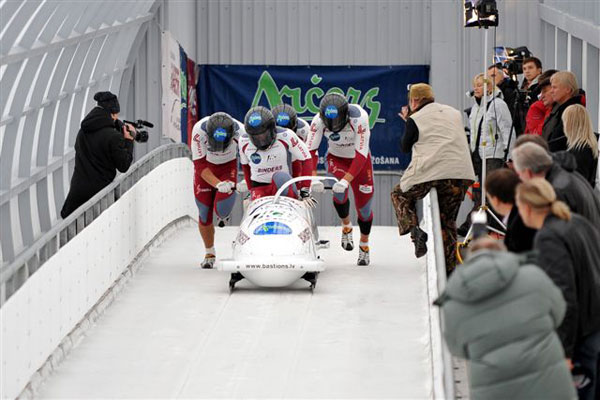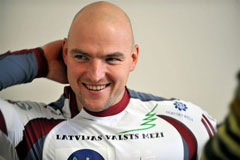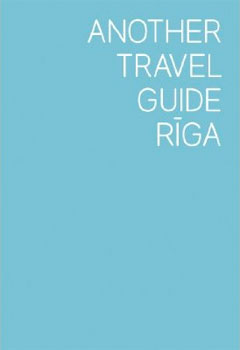
The Latvian bobsleigh team, led by driver Jānis Miņins, is among those set to compete in the 2010 Winter Olympics in Canada. (Photo courtesy of the Latvian Bobsleigh Federation)
The Winter Olympics, which this year begins Feb. 12 in Canada, is all about speed and finesse on ice and snow. For that you need cold weather or mountains. While Latvia has no mountains to speak of, it is the 10th most northerly country in the world and traditionally has had lots of snow and cold winters.
Not surprisingly, Latvia was one of 16 nations to participate in the first Winter Olympics in 1924 in Chamonix, France, sending just two athletes. This year, the country is sending its largest contingent ever—59 athletes competing in 10 disciplines.
Latvian Olympic Committee chair Aldonis Vrubļevskis on Jan. 26 announced the make-up of the team heading to Vancouver and Whistler.
Haralds Silovs is entered in both short- and long-track speed skating. Veterans Ilmārs Bricis will lead a team of nine in the biathlon. Pilot Jānis Miņins is part of an eight-man bobsleigh team. Also competing are two cross-country skiers, three downhill skiers and a snowboarder. Turin medalist Mārtiņš Rubenis and veteran Anna Orlova head a team of 10 lugers, including brothers Andris and Juris Šics. Brothers Mārtiņš and Tomass Dukurs will start in the skeleton.
Latvia’s men’s hockey team will play in Vancouver against Russia, the Czech Republic and Slovakia in the so-called “Group of Death” in the preliminary round. The top three teams in each of three groups will advance to the qualification playoffs and then on to the quarterfinals, semifinals and finals.
The National Hockey League is taking a break during the Olympics, allowing NHLers to join their national squads. Dallas Stars veteran defenceman Kārlis Skrastiņš will anchor Latvia’s 23-man squad. Sixteen of the players are from Dinamo Rīga of the upstart Kontinental Hockey League (KHL). Familiarity with each other will help the Latvian players as they face squads studded with top NHL stars. Also joining Latvia’s team will be rookie NHL blueliner Oskars Bārtulis; American Hockey League player Kaspars Daugaviņš, who got called up to the NHL for one game this season; a couple of players from Latvia who play elsewhere in the KHL; and two who play in the top German circuit.
As usual, there is some controversy around the selection of the national team, this time with the exclusion of the NHL Los Angeles Kings pugilist Raitis Ivanāns and top Atlanta Thrashers prospect defenceman Arturs Kulda, who has the best +/- results (calculated by subtracting the times the opposing team scores from the times your team scores in even strength or shorthanded play when you’re on the ice) in the AHL. This is typically indicative of a player’s defensive play and Kulda is waiting for a shot at the NHL. Kulda was recently included as one of three spares who will only play if others are injured.
Heading into the Vancouver 2010 Winter Olympic games, Latvia’s medal favourite is skeletonist Mārtiņš Dukurs. Born in 1984 and competing since 1998, Dukurs won this year’s World Cup skeleton title ensuring that he’ll start first at Whistler, the Olympic venue 124 kilometers north of Vancouver. His brother Tomass finished fourth. Dainis Dukurs is their father and coach.
Miņins’s four-man bobsleigh crew is currently ranked second in world standings and this third generation of Latvian bobsleighers could finally bring home a medal. Even though Haralds Silovs is the current European short track champion, at the Olympics he will have to compete against power Canadian, American, Chinese and South Korean squads that have dominated the sport.
Latvia’s team includes nine women. The average age is 27. The oldest competitor is back-up goaltender Sergejs Naumovs at 40 while cross-country skier Aneta Brice and downhiller Kristaps Zvejnieks are both 18. Ilmārs Bricis and Anna Orlova will have competed in all six Winter Games since Latvia regained its independence while lugers Rubenis and Guntis Rēkis are back for their fourth time. A total of 29 athletes, many of them from the hockey team, are making their Olympic debut. Six will celebrate birthdays during the games.
Latvia’s delegation will include a support crew of 46, primarily coaches and medical personnel with a few functionaries from the Latvian Olympic Committee. President Valdis Zatlers will be at the opening ceremonies and will be around for another four days to catch some of Latvia’s athletes in action before returning home.
For North American readers at home watching the games, the best chance of catching Latvian athletes will be in the bobsleigh, skeleton and luge where some of the athletes will have Top 10 starting positions as they go head-to-head with Winter Olympic powerhouses such as Canada, the United States and Germany.
The opening ceremonies for the Vancouver 2010 Winter Olympics kick off Feb. 12 and the games run through Feb. 28. More than 5,000 athletes from 91 countries, including some not so cold countries, are expected to compete in 15 sports. The Paralympics Games will follow March 12-21. Readers can follow the results on the official games site at www.vancouver2010.com. The uniforms that Latvia’s team will wear at the opening ceremonies can be seen on the Latvian Olympic Committee’s Web site.
Latvia’s Winter Olympic history
Latvia was at the first three Winter Olympics held before World War II. Speedskater Alberts Tumba and cross-country skier Roberts Plūme competed in the games in Chamonix, France, while Rumba returned and was the only entrant in 1928 at St. Moritz.
The number jumped to 26 athletes at Garmisch-Partenkirchen in 1936. They included 11 from the men’s hockey team. Latvians athletes were entered in speed skating, figure skating, downhill and cross-country skiing. Figure skater Alīse Dzegūze, pairs figure skater Hildegarde Švarce and downhiller Mirdza Martinsone were the first Latvian women in the Winter Olympics. Speed skater Alfons Bērziņš was 14th on a 500-meter course but three years later in 1939 he was crowned European champion in Rīga and a few weeks later earned a silver at the World Championships in Helsinki.
Even though Latvia’s pre-war Summer Olympians bagged two silver and one bronze as well as a bronze in 1912 during the Czarist era, the winter athletes came home empty. It was well into the Soviet occupation before Latvian athletes mounted the winter podium.
That happened at the 1980 Games in Lake Placid, when Latvian athletes competing for the Soviet team picked up a gold, silver and bronze. Vera Zozuļa won the gold in the women’s luge while Latvian hockey star Helmūts Balderis received the silver medal as a member of the Soviet team that lost to the United States in the famed “Miracle on Ice” game. Luger Ingrīda Amantova picked up a bronze. Zozuļa, like others, has gone on to coach and one of her charges is Anna Orlova, who has been Latvia’s top female luger since independence.
The luge, bobsleigh and, recently, the skeleton emerged as big winter sports in Latvia during the latter part of the Soviet occupation and in newly independent Latvia, whose athletes returned to the Winter Olympics under their own flag in 1992 at Albertville in France. The Latvian Olympic Committee was reestablished in 1988.
Luge was the first. The foundations were laid in 1967 by a group of enthusiasts who built a run near Cēsis. This was followed by the Soviet decision in 1972 to officially adopt the sport. Latvian athletes were off and running, quickly earning positions on the Soviet squad.
One of the lugers, Rolands Upatnieks, moved on to become the first head coach of the Soviet bobsleigh team in 1980 after the decision was made to participate in that sport. Here, too, Latvian bobsleighers quickly dominated the Soviet team. Ten of 16 athletes on the first bobsleigh team were Latvians. Most crossed over from track and field. At the Sarajevo games in 1984, Zintis Ekmanis from Latvia and Vladimirs Aleksandrovs from Russia proper won the bronze in the two-man bobsleigh.
During the Calgary games in 1988, Jānis Ķipurs was a member of the gold-winning Soviet two-man crew while three Latvians, Jānis Ķipurs, Juris Tone and Guntis Osis, were on the four-man crew that won bronze. Ķipurs painted his sleigh in Latvia’s national colours to protest the Soviet occupation.
Backup goaltender Vitālijs Samoilovs from Rīga on the Soviet hockey squad also returned from Calgary with a gold medal.
Following January 1991, when thousands of people—including Latvian athletes—blocked off and manned the barricades for days in the Old Town of Rīga in an attempt to protect their parliament from a possible Soviet attack, Latvian bobsleighers and hockey star Arturs Irbe refused to ever again participate on Soviet sports teams.
A huge stimulus for the luge and bobsleigh was the 1986 completion of the track at Sigulda. Starting at almost 20 meters above the ground in a tower high above the Gauja River, the track plummets in hair-pin turns down the valley. It was designed for the two-man bobsleigh and is shared with the luge and now the skeleton, a sport which returned to the Winter Olympics in 2002 after a 54-year absence. However, the first turn on the elevated portion of the track is too tight for the four-man bobsleigh.
With the restoration of Latvia’s independence there were high hopes that former Soviet athletes would come through big at the Albertville (1992) and Lillehammer (1994) games. That was not the case. Latvia was turned inside out as it struggled to transform itself after 50 years of Soviet occupation and the sports community was no exception. Especially hard hit were the bodsleighers. Their sport is high-tech and bobsleighs are expensive. Then there’s the cost of participating in the annual World Cup circuit and lugging the sleighs around.
It was now easier to qualify as part of the Latvian rather than Soviet team and Latvian bobsleighers were joined by those competing in speed skating, short-track skating, biathlon, figure skating, cross-country and downhill skiing. Unfortunately there were only a lot of distant and a few close finishes but no medals. With the qualification of the men’s hockey team at Salt Lake City (2002) and Turin (2006), the number of athletes from Latvia in the Winter Games increased by more than 20.
Even though Latvia’s winter athletes were winning medals at European championships in the luge, bobsleigh, biathlon and short-track skating, the country had to wait until the 2006 Turin games for its first post-independence Winter Olympics medal. Rubenis won a bronze medal in the luge.
Only one athlete from Latvia’s post-war diaspora made it to the Winter Olympics. That was Canada’s speed skater Silvia Burka from Winnipeg, who participated in three games at Sapporo (1972), Innsbruck (1976) and Lake Placid (1980). Her best result was fourth place in the 1,000-meter competition at Lake Placid.

Jānis Miņins pilots the Latvian bobsleigh team that is ranked second in the world. (Photo courtesy of the Latvian Bobsleigh Federation)






